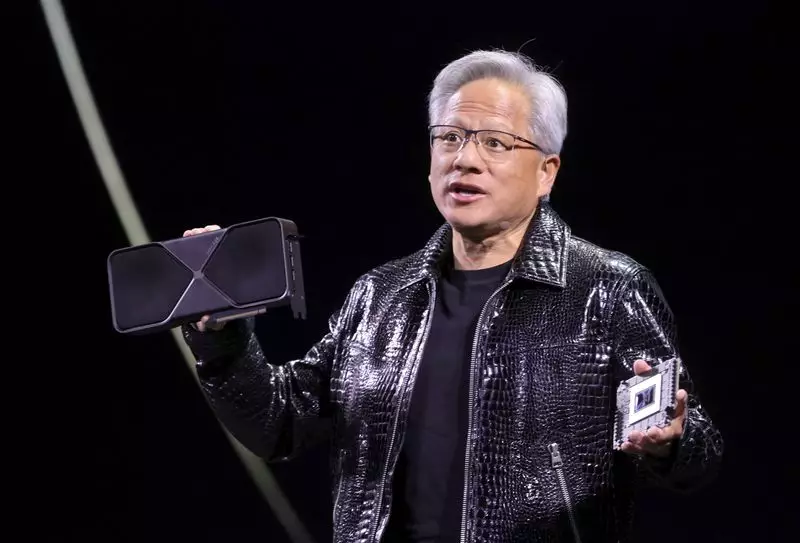At the Consumer Electronics Show (CES) 2025 in Las Vegas, Nvidia’s CEO Jensen Huang showcased a series of groundbreaking products positioned to redefine the intersection of artificial intelligence (AI) with consumer technology. The annual event has become a platform where tech giants unveil transformative innovations, and this year was no exception. Nvidia, which is second in market value only to Apple, highlighted its ambition to marry its cutting-edge AI capabilities with more accessible consumer hardware. The introduction of new tools aimed at enhancing both gaming experiences and industrial applications is set to challenge existing paradigms within the tech industry.
One of the most intriguing announcements was the introduction of Nvidia’s Cosmos foundation models. These models are designed to generate photorealistic video snippets that can simulate real-world scenarios, significantly enhancing the training of robots and autonomous vehicles. By producing synthetic data, Cosmos aims to alleviate the costs associated with traditional data collection methods, which often involve extensive real-world testing and human-assisted programming.
Huang emphasized the innovative potential of these foundation models, suggesting that they could parallel the impact that Llama 3 had on the enterprise AI sector. By allowing users to input text prompts, Cosmos will enable the creation of unique video data that adheres to physical laws, making it a powerful alternative for AI training. However, skepticism remains from analysts such as Bank of America’s Vivek Arya, who questioned whether this venture would convert into a reliable, scalable business model. The challenge lies in making robotics both cost-effective and efficient, which could determine the actual market applicability of Nvidia’s latest innovations.
Nvidia also made waves with its announcement of the RTX 50 series gaming chips, which leverage the company’s proprietary ‘Blackwell’ AI technology. This line of chips aims to elevate gaming graphics to unprecedented levels, catering to an industry that increasingly demands realism in its visual output. With prices ranging from $549 to $1,999, the new chips promise to enhance visual experiences through advanced shaders, making even mundane objects, like ceramic teapots, appear lifelike with added imperfections.
The gaming sector has been a substantial revenue generator for Nvidia, and experts like Ben Bajarin of Creative Strategies believe that these new chips will catalyze a surge in sales. The gaming market’s insatiable appetite for improved graphical fidelity and realism gives Nvidia a strategic advantage, especially with the anticipated demand for enhanced human facial representations that can draw players further into the game environment. The excitement surrounding the RTX 50 series, set to roll out in stages starting January 30, reflects a vibrant consumer tech ecosystem eager for innovative experiences.
For the first time, Nvidia is stepping into the personal computing arena with the introduction of Project DIGITS, a desktop computer designed specifically for programmers and developers. Priced at $3,000, this machine integrates the same chips that power Nvidia’s data center solutions, designed to optimize AI system testing and deployment for individual developers. Unlike typical consumer-focused computers, Project DIGITS stands out as a high-performance tool tailored for those who demand advanced processing capabilities.
The decision to develop a desktop computer signifies Nvidia’s intent to expand its influence beyond the GPU market, positioning itself as a holistic technology provider for developers involved in AI. With the growing demand for robust computing solutions in the AI space, Project DIGITS could carve out a niche market among developers needing significant computational power for machine learning and other AI-related tasks.
Nvidia’s ambitions are not limited to consumer technology; the company is also making strides in the automotive sector. The collaboration with Toyota to integrate Nvidia’s Orin chips in various vehicle models underscores the increasing importance of AI in enhancing driver assistance systems. This move aligns with the broader industry trend of incorporating advanced technology into vehicles, pushing the boundaries of automotive safety and intelligence.
Huang forecasted an increase in automotive hardware and software revenues, projecting a rise to $5 billion in fiscal year 2026, up from $4 billion, underscoring Nvidia’s significant position in the automotive tech landscape. Such collaborations exemplify how Nvidia is positioning itself at the heart of the AI-driven automotive evolution, setting the stage for transformed driving experiences that leverage sophisticated AI capabilities.
Nvidia’s announcements at CES 2025 reveal a bold vision for the future of technology, intertwining advancements in AI across multiple sectors, from gaming to robotics to automotive applications. As the innovation unfolds, Nvidia’s relentless drive to expand its market presence will undoubtedly impact how technology interacts with consumers and industries alike. While uncertainties persist regarding the scalability of its new offerings, the potential for transformative change is palpable, marking a significant chapter in the ongoing narrative of AI and consumer technology integration.

